The steamy side of McGill
The pigeons appreciate them, as passengers may notice getting off the bus at the northeast corner of Pine and University where the birds huddle on the grate, taking advantage of the warm air rising from below. Homeless people have been known to live in them to escape the chill of winter. And a good number of Arts students and staff use them to get to the McLennan Library or the Redpath Museum from the Arts Building, all the while never having to put a foot outdoors.
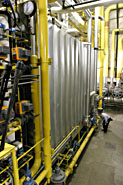
Inspecting the pipes at McGill's Power House
Owen Egan
I'm speaking of McGill's steam tunnels, a little-known underground network, connecting the Power House — an anonymous looking building, tucked in behind the Ferrier Building and across the road from the James Administration Building — to nearly all the buildings of the downtown campus, including the McIntyre Medical Building, the Montreal Neurological Institute and the Currie gym. Since the January 26–69 Energy Awareness Week, when student volunteers took a few dozen members of the McGill community on tours of the Power House and tunnels, the network is better appreciated.
"At one point, we even provided steam for the Royal Vic," says Alain Fournier, supervisor of the Power House, who estimates that there are three kilometres of tunnels.
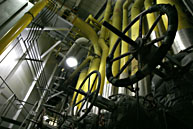
Metre-wide valves open the steam pipes
Owen Egan
Some, like the better-known Arts-Redpath-McLennan are high and wide enough to accommodate a fair amount of human traffic alongside the big pipes, which are either full of steam flowing out to the buildings, or bringing condensed steam, back to the Power House. Others, like the tunnel from the Power House to that other power house, the Administration Building, are just high and wide enough for workers to do their checking and maintenance. Think Indiana Jones minus the rats. Rats and their kin, according to Fournier are not a feature of the steam tunnels.
Humans, however, have taken up residence, periodically. Tom Thompson, senior development advisor of Development and Alumni Relations, recalls that during the renovation of the Strathcona Anatomy & Dentistry Building, a naked man was found living in the steam tunnel running north, underneath Pine Avenue. With temperatures running from 25 to 40 degrees Celsius, the attraction in winter is understandable.
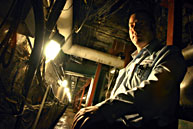
Joël Lepage, Power House technician
Owen Egan
The tunnels are inspected once per month, says Fournier. "So, for one month, it's free rent if they [homeless people] get the timing right," he laughs.
On this particular day, Joël Lepage, a technician at the Power House, has spotted a few leaks of steam. Just before exiting the tunnel, we find a group of Power House technicians having lunch. To their left are a couple of swinging doors. Pushing on them, where do we end up but in the granite and marble elegance of the foyer of the James Building. Once the doors close to form what appears to be a black wall, there is no sign of the hot, damp and noisy activity beyond that keeps the university heated.
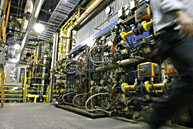
A convoluted network of pipes and machinery
Owen Egan
Returning to the Power House, Lepage shows me and Ted Paulus, a chemical engineering student who's leading the tour, just how the system works. City water and 100,000 cubic metres of natural gas daily (in the winter) are the starting ingredients. When Gaz Métropolitain is running low on gas, McGill changes to oil but it's messier to use, has to be delivered and must undergo an ionizing process before combustion, notes Lepage. This year (unusually) gas is cheaper than oil.
Two huge boilers — three on extremely cold days — burning at 1000 degrees Celsius, heat the water, which is first treated to remove the corrosive oxygen, he explains. From here, the steam leaves in a cluster of huge pipes, each heading to a different direction of the campus. Once at the destined building, that building's mechanical room uses the steam to heat its own water and provide heat, either through radiators or the ventilation system.
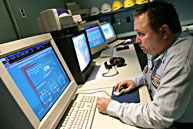
Roger Plante monitors the system
Owen Egan
This is an old and a good system, notes Fournier. The older tunnels date from the construction of buildings early in the last century when the boilers were originally coal-fired. All the recent buildings, such as Wong and Trottier, are part of the system. Only the houses, on such streets as University and Peel, are heated independently. With a complete renovation of the Power House almost completed, Fournier is confident that the system will be here for the century to come.
